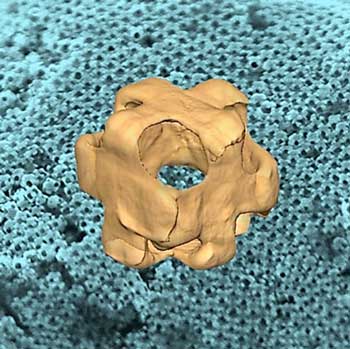| Mar 24, 2020 | |
Engineered nanowrappers carry and release tiny cargo(Nanowerk News) Scientists have discovered a new method for creating hollow metallic nanostructures with regularly spaced and sized pores (ACS Central Science, "Tailoring Surface Opening of Hollow Nanocubes and Their Application as Nanocargo Carriers"). They used advanced electron tomography to collect three-dimensional images at different stages of synthesis. The images allowed the scientists to track the transition from gold nanocubes with sharp corners to gold-silver alloy nanowrappers with pores at their corners. The pores are large and regular enough to carry molecule or nanoscale-size particles of drugs and other substances. |
|
 |
|
| At center, a 3D electron tomogram image of a hollow gold-silver alloy nanowrapper showing the pores at each corner. The background is a scanning electron microscope image of a large number of nanowrappers assembled into a superlattice. (© ACS) | |
| Hollow nanoparticles have until now been difficult to make with regularly sized and spaced openings. The lack of regularity makes it hard to use them to carry other materials. This new one-step method synthesizes tiny gold-silver alloy nanowrappers with cube-shaped openings at their corners. This allows the nanowrappers to carry and release tiny particles of other materials. | |
| These nanowrappers have a huge range of potential applications in medicine, catalysis, and other fields. For example, they could deliver contrast agents for medical imaging or carry drugs for highly controlled release. | |
| Nanoparticles are particles that measure 1 to 100 nanometers (1 to 100 billionths of a meter) long, wide, and high. Hollow nanoparticles have potential for many applications due to their unique physical and chemical properties, including how they scatter light and absorb energy. Regular surface openings are important because they could carry and deliver other materials. | |
| However, current methods cannot adequately control the shape, size, and location of these openings, and they can only make nanoparticles able to carry molecule-size objects, not larger nanoscale objects. | |
| Scientists developed a one-step strategy to synthesize hollow nanoparticles with cubic openings at their corners. They used electron microscopes at the Center for Functional Nanomaterials at Brookhaven, which provides synthesis and fabrication laboratories and instrumentation. The scientists used advanced electron tomography to obtain three-dimensional visualizations of the transformation of sharp-cornered gold nanocubes to gold-silver alloy nanowrappers with cubic pores. | |
| The final product is a single-crystalline gold-silver alloy with three “belts” that wrap around a hollow center to form a cube called a nanowrapper. The nanowrappers’ hollow architecture allows them to carry nanoobjects, while the openings at the corners enable controlled loading and release of nanoscale particles. | |
| The new method also allows structural tunability, which allows the nanowrappers to be tuned to absorb light ranging from visible to near-infrared for applications such as medical phototherapy to destroy cancerous or diseased tissue. |
| Source: Brookhaven National Laboratory | |
|
Subscribe to a free copy of one of our daily Nanowerk Newsletter Email Digests with a compilation of all of the day's news. |
